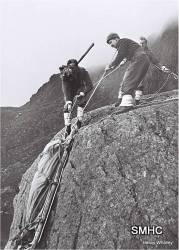
The Scottish Mountain Heritage Collection
Objects Database
Talurit Clamp - Belay Plate
Accession Number
1226.2015.1(a-b)
Object Name
Talurit Clamp - Belay Plate
Created
08/04/2015
Creator
Hermione Cooper
Accession Date
08/04/2015
Brief Description
A Talurit clamp and belay plate
Materials
metal
Dimensions
a- 7.5(h) x 6.5(w) x 4.5(d)cms b- 8(h) x7(w) x 4.5(d) cms
Number Of Objects
2
Colour
silver
Maker
Martin Mackie
Provenance
This is a very special and unique bit of gear - we think it's the only one in existence and consequently not everyone knows what it is. It's actually a very early belay plate which has been created from a swage which is a form of clamp used for joining wire cables together - in this case two large electricity cables.
The inventor was a guy called Martin Mackie who was an engineer in the Royal Air Force and member of the RAF Mountain Recue Team.
The trade name for a swage like this is a Talurit Clamp and Martin adapted one whilst based at RAF Akrotiri in the 1960's. All he really had to do was smooth the edges and drill holes which lightened it, helped dissipate the heat and allowed for a karabiner to be clipped.
Back in those days body belays were the norm and it took around six men to lower a mountain rescue stretcher but when using his new device Martin could manage the whole operation on his own.
Belay plates, which are basically friction devices, were pretty embryonic back in those days so Martin was way ahead of his time in creating this fabulous piece of kit. Fortunately, fellow mountain rescuer, John Cuthbertson, held on to this one and kindly donatedit to our collection in 2014. It's well worn having controlled many a stretcher lower but is still servicable 45 years after being made - thanks Dave and thanks Martin.
Acquisition Method
Donated by John Cuthbertson
Acquisition Date
08/04/2015
Condition Check Date
08/04/2015
Rules
Spectrum : UK Museum documentation standard, V.3.1 2007
Modified
08/04/2015

